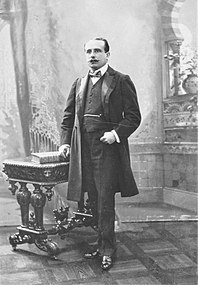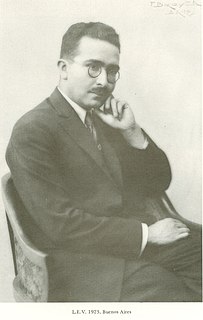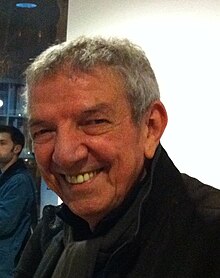
Chiclayo is the principal city of the Lambayeque region in northern Peru. It is located 13 kilometers inland from the Pacific coast and 770 kilometers from the nation's capital, Lima.

Tacna is a city in southern Peru and the regional capital of the Tacna Region. A very commercially active city, it is located only 35 km (22 mi) north of the border with Arica y Parinacota Region from Chile, inland from the Pacific Ocean and in the valley of the Caplina River. It is Peru's tenth most populous city.

José Simón Pardo y Barreda was a Peruvian politician who served as the 42nd (1904–1908) and 46th (1915–1919) President of Peru.

La Victoria is a district of the Lima in Peru and is one of the most populous districts comprising the city of Lima.

Jesús María is one of the most centrally located districts of Lima, Peru. It is a upper class, high-density district and it usually ranks in the top districts with the best quality of life in Peru with an HDI of 0.8372 (2019), only behind the districts of La Molina and Lince.

Antonio Raimondi was a prominent Italian-born Peruvian geographer and scientist. Born in Milan, Raimondi emigrated to Peru, arriving on July 28, 1850, at the port of Callao. In 1851 he became a professor of natural history. In 1856, he was one of the founding professors of the medical school at the National University of San Marcos; in 1861, he founded the analytical chemistry department.
Héctor García Ribeyro was a Peruvian politician and businessman born in Lima, Peru on February 16, 1909 and died in Arequipa, Peru on May 12, 1963. He was the Mayor of Lima from 1956 to 1962 prior to that he had been a Council Member in the Lima City Council from 1939 to 1945 and Mayor of Ancon from 1952 to 1956. Married Maria Ayulo Vargas in 1940 in Lima-Peru the father of Hector, Gonzalo and Felipe He was a Board member of Banco Popular del Peru, Enrique Ferreyros, Corporacion del Santa, & Co. Chairman Compañia Hotelera Peruana, among others.

Felipe Santiago de Salaverry was a Peruvian soldier and politician who served as the 13th President of Peru.

The Real Felipe Fortress was built to defend the main Peruvian port and the city of Lima from pirates and corsairs during colonial times. The fortress was pivotal in the 1866 naval battle between a Spanish fleet sent to South America to "reclaim" its colonies and land batteries in the coast of Peru. The Real Felipe Fortress is currently the Peruvian Army Museum, displaying historical uniforms, weapons and other military paraphernalia.

The Plaza San Martín is one of the most representative public spaces of the city of Lima, Peru. It is located at the ninth block of Colmena avenue, within the Historic Centre of Lima which was declared a World Heritage Site in 1988 by UNESCO. It is located near the Plaza Mayor of Lima and is connected to it by the Jiron de la Union. Its central monument gives homage to Peru's liberator, José de San Martín.

Ricardo de Jaxa Małachowski – was a Polish-Peruvian architect, active in Peru, one of the major architects of the capital city of Lima.

Felipe Cossío del Pomar was a Peruvian painter and left-wing political activist. While in exile from Peru he founded an art school in San Miguel de Allende in Mexico in 1938. The school failed, but on his return in 1950 he founded the Instituto Allende, a university-level arts school that was still active in 2014. The short film "Felipe Cossio del Pomar in San Miguel de Allende", by Ezequiel Morones is in Youtube.
Bernardo Fort-Brescia is a US-based Peruvian businessman and architect. He is the co-founder of the architectural firm Arquitectonica. He is a fellow of the American Institute of Architects (AIA). He won the AIA Silver Medal. He is also an heir to Grupo Breca.

Enrique Fidel Verástegui Peláez , was a Peruvian author and mathematician. He was a member of Movimiento Hora Zero with the poets Jorge Pimentel, Juan Ramírez Ruiz, Jorge Nájar, Enriqueta Belevan and Carmen Ollé.

Princess Christian of Hanover, née Alessandra Lisette de Osma Foy is a Peruvian attorney, handbag designer, and former model. She is a member of the Hanoverian royal family through her marriage to Prince Christian of Hanover.

Enrique Iturriaga Romero was a Peruvian composer and educational theorist.

Luis Eduardo Valcárcel Vizcarra was a Peruvian historian, anthropologist, writer and activist. He was a researcher of pre-Hispanic Peru and one of the protagonists of the Indigenismo movement. He is considered the father of Peruvian anthropology, and his work focused on two fundamental axes: the revaluation of the Inca Empire and the vindication of the Andean culture. He brought awareness to the continuity that links the peasant of the Andes with the man of the Tahuantinsuyu.















